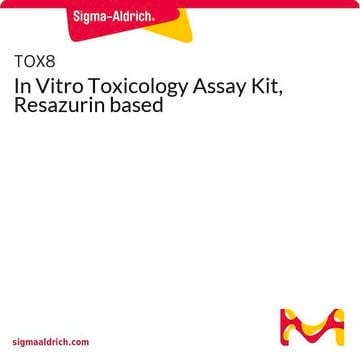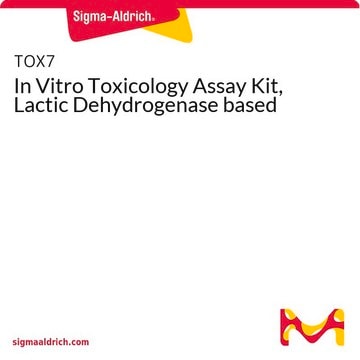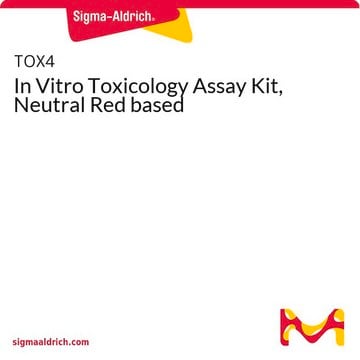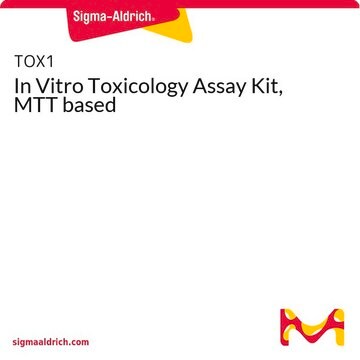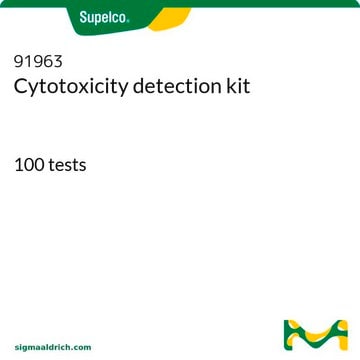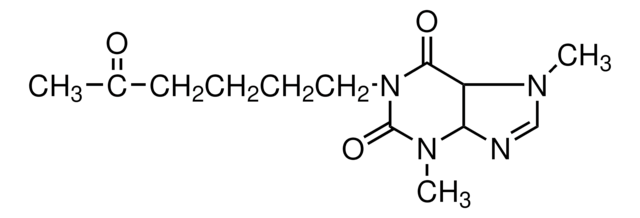Product TOX6, In Vitro Toxicology Assay Kit Sulforhodamine B can be used with both adherent and suspension culture.The advantage of layering the fixative directly onto the media is that this allows the assay to work for cells in suspension. Otherwise, you need to centrifuge, remove the media and then fix. Also, it is possible to loose cells when you remove the media. It was found that adding the fixative works for the assay and the protocol was changed in 2003.
TOX6
In Vitro Toxicology Assay Kit, Sulforhodamine B based
Sinónimos:
biomass viability assay, sulforhodamine B, total biomass assay
Seleccione un Tamaño
MXP 7,483.00
Seleccione un Tamaño
About This Item
MXP 7,483.00
Productos recomendados
Formulario
liquid
uso
1 kit sufficient for 1,000 tests
envase
pkg of 1 kit
condiciones de almacenamiento
dry at room temperature
λmáx.
565 nm
aplicaciones
cell analysis
detection
método de detección
colorimetric
temp. de almacenamiento
room temp
Descripción general
Aplicación
Acciones bioquímicas o fisiológicas
Palabra de señalización
Danger
Frases de peligro
Consejos de prudencia
Clasificaciones de peligro
Aquatic Acute 1 - Aquatic Chronic 1 - Eye Dam. 1 - Flam. Liq. 3 - Skin Corr. 1A
Código de clase de almacenamiento
3 - Flammable liquids
Elija entre una de las versiones más recientes:
Certificados de análisis (COA)
¿No ve la versión correcta?
Si necesita una versión concreta, puede buscar un certificado específico por el número de lote.
¿Ya tiene este producto?
Encuentre la documentación para los productos que ha comprado recientemente en la Biblioteca de documentos.
Los clientes también vieron
Artículos
Cell based assays for cell proliferation (BrdU, MTT, WST1), cell viability and cytotoxicity experiments for applications in cancer, neuroscience and stem cell research.
-
Can you use Product TOX6, In Vitro Toxicology Assay Kit Sulforhodamine B based with suspension cells?
1 answer-
Helpful?
-
-
When using Product TOX6, In Vitro Toxicology Assay Kit Sulforhodamine B based, what happens if I add kit component Product T5413, 10 mM Tris Base Solution, prior to fixing the cells?
1 answer-
If the 10 mM Tris Base Solution, Product T5413 is added to the cells before the TCA (fixative), the cells will be lysed. This reagent is not buffered and is not isotonic. The assay cannot be rescued if this occurs.
Helpful?
-
-
What is the Department of Transportation shipping information for this product?
1 answer-
Transportation information can be found in Section 14 of the product's (M)SDS.To access the shipping information for this material, use the link on the product detail page for the product.
Helpful?
-
Active Filters
Nuestro equipo de científicos tiene experiencia en todas las áreas de investigación: Ciencias de la vida, Ciencia de los materiales, Síntesis química, Cromatografía, Analítica y muchas otras.
Póngase en contacto con el Servicio técnico